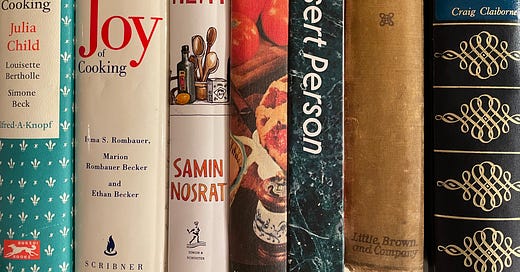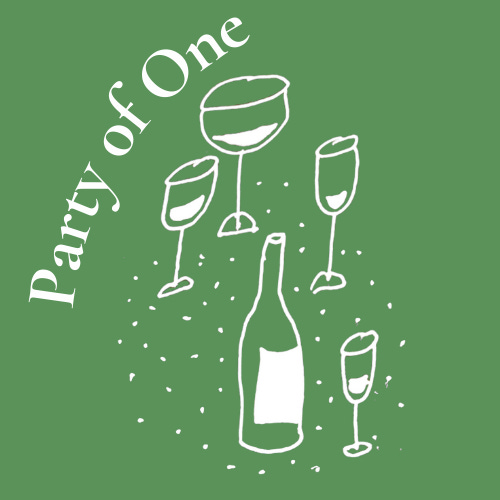Welcome back to the newsletter. I took a week off because I wanted to. Spring break was great, but it didn’t really feel like a break. My trip to DC was bittersweet — it was the last one before graduation — but we didn’t eat out as much as we thought we would. I ate to survive last week, so there was nothing exciting to share, unless your mouth waters at the sight of salmon and rice. (If this is an interesting topic, I’d be happy to write more about eating for survival vs. fun!)
I’m heading back home at the end of May, and the stress of moving is upon me. So when my parents came to visit me two weeks ago, I loaded their car with bags and boxes full of my least used things. Going through my books is always tough, because whether I reread them or not, I like having my favorites close by.
When I started collecting cookbooks, I was determined to add all of the “classics” to my bookshelf. It took a few months of scouring used bookstores for titles like Mastering the Art of French Cooking and The Joy of Cooking; they now perch on my shelf like trophies. I don’t use them every week, but they’re good references and I like being in the company of Julia Child (don’t we all?). So I kept the “classics” and sent home the ones that aren’t as special to me.
But, what makes something a “classic”?
In the case of cookbooks, one might consider books used by their grandparents as classics or icons. “Classic” is defined by Merriam-Webster as “serving as a standard of excellence : of recognized value.” Classic cookbooks have stood the test of time, their influence enduring. But it’s important to consider who one’s grandparents — or cultural background in general — are when thinking about the concept of a “classic.”
In my food studies course this semester, we read Cultivating Food Justice: Race, Class, and Sustainability by Alison Hope Alkon and Julian Agyeman, and in it they argue that the food movement, which swept the country in the late 20th century, was built on ideals held by white people. Alkon and Agyeman discuss Michael Pollan’s Food Rules — a book I love and once preached about in an essay on self acceptance and eating — and how so many of the rules are rooted in the white American experience. I won’t go on further, but you can find the book here.
This is all to say that I have broadened my outlook on the concept of what a “classic” cookbook can be. Food is one of the most subjective things on this planet — each of us brings our own understanding of it to the table based on our upbringing, which I think makes conversations around food so enlightening. To me, these classics are books that I revisit again and again and continually learn from.
Classics don’t have to be old books; they can be published as recently as 2020. The cookbook market has grown considerably in the past few years, which is surprising since there are so many free recipes published online each day. Think about it: how many recipe videos did you scroll by this morning? Maybe I’m an old soul, but I love cracking open a cookbook when dinner time rolls around.
If you indulge in cookbooks too, what’s your favorite title? Do we have the same faves?
7 classic cookbooks for your consideration
The New York Times Cook Book by Craig Claiborne
Craig Claiborne became the first food editor and restaurant critic of the New York Times in 1957 (and he was the first man to have that title in the country). He published this cookbook four years into his career at the Times, and since then there have been multiple reissues of it. Most recently, Amanda Hesser (who co-founded Food52) published The Essential New York Times Cookbook, which I’d love to get my hands on. My mom found this copy of Claiborne’s edition for me at a store in Ambler, PA, and I believe it’s a first edition! Claiborne dedicated it to Ruth P. Casa-Emellos, who served as the Times’ home economist for eighteen years. In the 20th century, food news and recipes were relegated to newspapers “women’s pages” because only ladies care about food, right? It’s thanks to women like Ruth who made Claiborne’s book possible. To learn more about women’s pages, check out this Splendid Table podcast episode.
The Boston Cooking School Cook Book by Fanny M. Farmer
Fanny M. Farmer is considered the nation’s first true cookbook author. Before this book was published in 1896, there was no standard measurement system in place when it came to sharing recipes. I looked for this book when I visited Boston last year, but to my surprise there were no copies to be found (unless I was in the wrong bookstores). I got this copy last summer at Bonnie Slotnick’s in the East Village. Bonnie has so many editions of this book — I picked up the oldest one she had at the time, which was published in 1927. This book is inscribed with “In hopeful anticipation,” which makes me think it was a gift to a bride-to-be. Buying used books is like holding onto someone’s history. So cool!
Dessert Person by Claire Saffitz
Surprisingly, this is the book I’ve used the most in my collection. I always have fun when I pry this one off the shelf. Whether I’m returning to a crowd favorite (like the buttermilk miso biscuits) or jumping into a recipe for the first time (I’ve been eyeing Aunt Rose’s Mondel Bread), it is always a pleasure to be in Claire Saffitz’s glory. Flipping through Dessert Person on a bad day cheers me up — as does the book’s YouTube channel.
Betty Crocker’s Picture Cook Book
This book is absolutely absurd. Published in 1956 by General Mills, it serves as an American housewife handbook. Nevertheless, it’s jam-packed with a bunch of mid-century American recipes like chiffon cake, sea food symphony, and tomato aspic. It smells like an antique store and serves as a time capsule of the point in time when home cooking became serious. I wouldn’t be surprised to find a Betty Crocker recipe or two on a women’s page somewhere. Some of the home economics tips are just wild. “If you feel tired, lie down on the floor on your back” and “Notice humorous and interesting incidents to relate at dinnertime when family is together” are some of my favorites. Bonus fun fact: Betty Crocker wasn’t a real person. She was dreamed up by advertising men 101 years ago! Check out this article from PBS.
Salt Fat Acid Heat by Samin Nosrat
If you ask any of my food studies professors about this book, they’ll beg you to read it from cover to cover. I haven’t done so YET, but I have watched the Netflix show! Samin Nosrat wrote Salt Fat Acid Heat after years of working in the restaurant industry. (She worked at Chez Panisse in college, which is kind of a very cool deal.) The book is considered an encyclopedia of cooking that promises “anyone can cook anything and make it delicious.” All you need to master are salt, fat, acid, and heat!
The All New Joy of Cooking by Irma S. Rombauer and others
Irma S. Rombauer first published The Joy of Cooking in 1931, and the series prides itself on being “the most authoritative cookbook in America.” I’d have to agree. My updated copy was published in 1997, the seventh of eight editions, by Irma’s daughter and grandson. Totaling over 1,000 pages, this book is a treasure trove of information, too. I particularly love the reference section in the back of the book because who doesn’t love a reference section? Need info on cooking methods? Or serving sizes? Or a comprehensive list of almost every ingredient under the sun? Then pick up a copy of The Joy of Cooking. I return to these pastry recipes again and again because of their simplicity, but would love to do a whole meal using the recipes from this book.
Mastering the Art of French Cooking by Julia Child, Louisette Bertholle & Simone Beck
Last but not least, Julia Child. What is there to say about Mastering the Art of French Cooking that hasn’t been said already? First published in 1961 (the same year as Claiborne’s book, and the year my dad was born), Child and her coauthors, Louisette Bertholle and Simone Beck, changed the course of cooking in the States forever. I dream about hosting a dinner party centered around this book, where we’ll watch this version of Julie & Julia. Also, if you haven’t read My Life in France, read it! She writes with such charm. My favorite line from the book is about Jack Hemingway’s wedding:
By the end of the afternoon I was thoroughly marinated with strawberries and cherries, champagne, brandy, Monbazillac, Montrachet, and Calvados, and speckled by tidbits of grass.
Here’s a post from last summer when I made Child’s ratatouille!







I have that Betty Crocker book here in the UK, cost me a fortune to get it sent over but there are a few movie star recipes in it!
Great choices, I think the tartine book is up there for bread people!